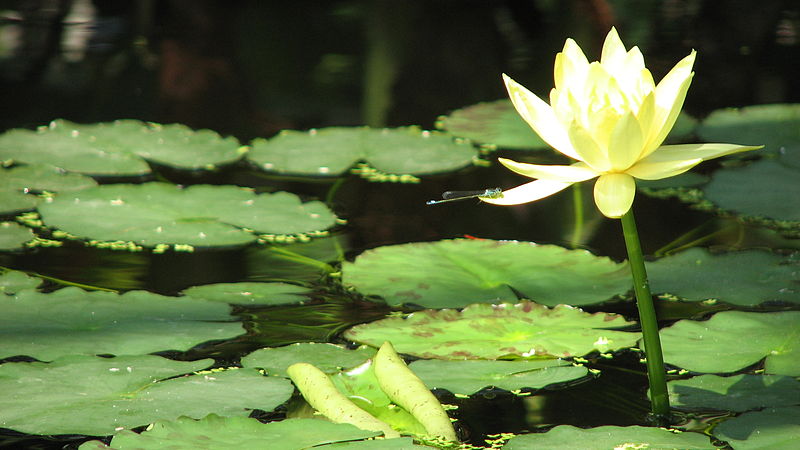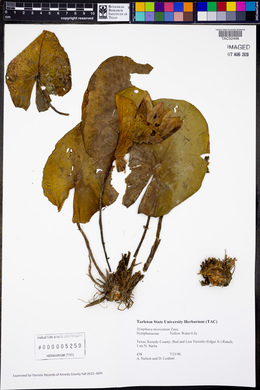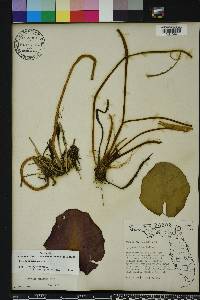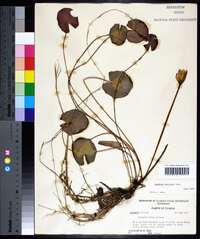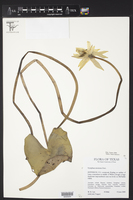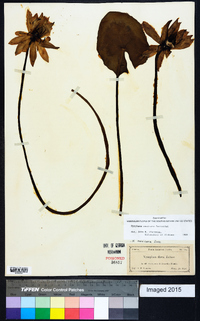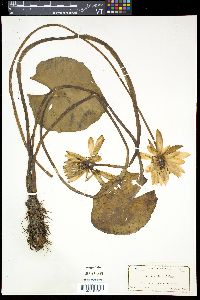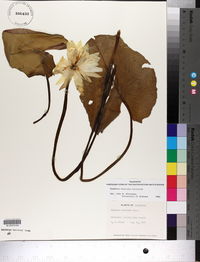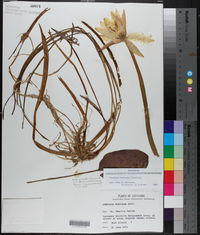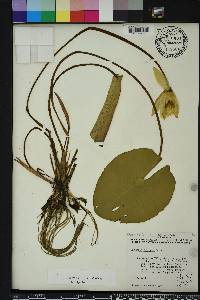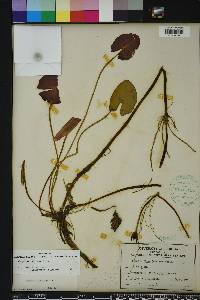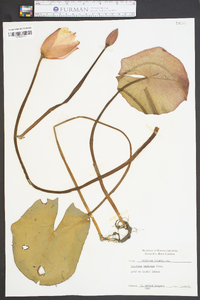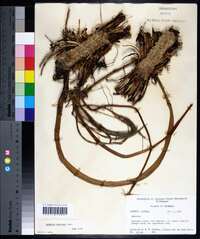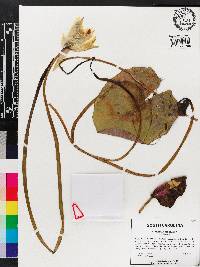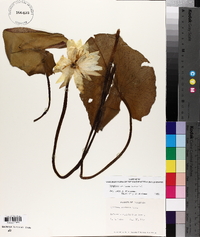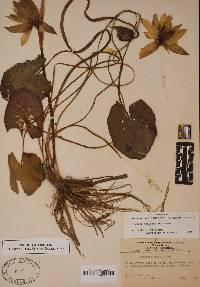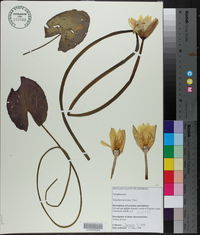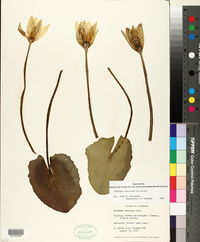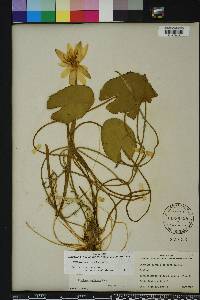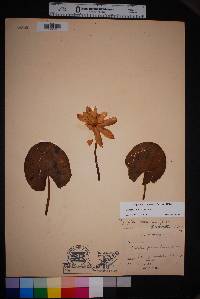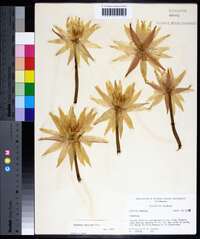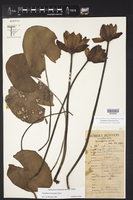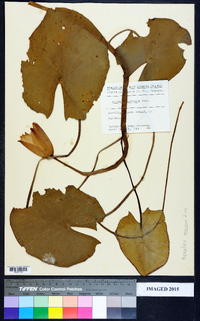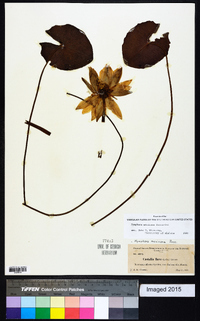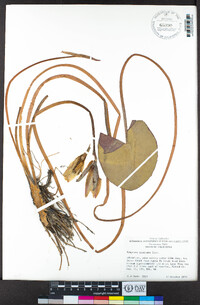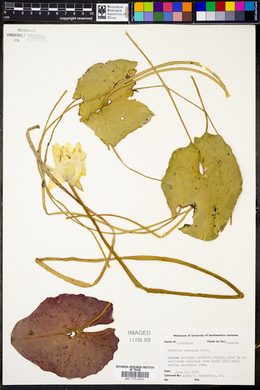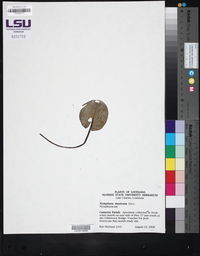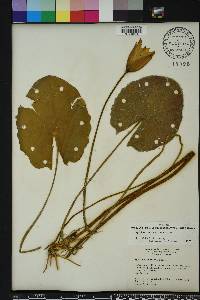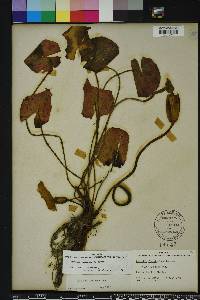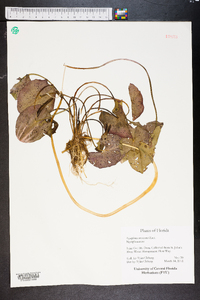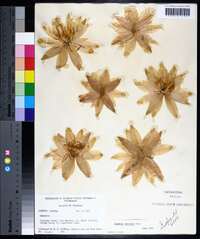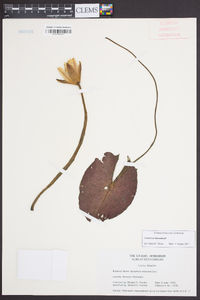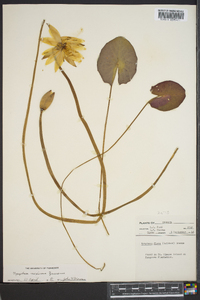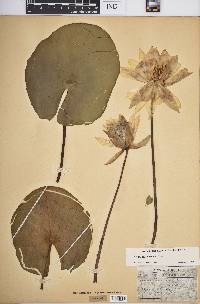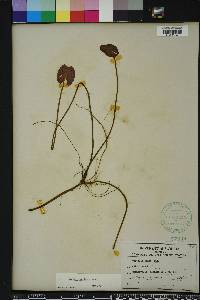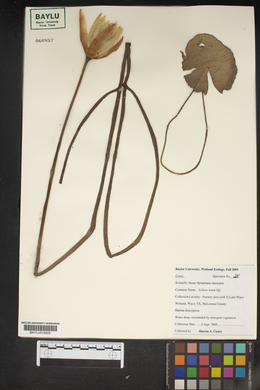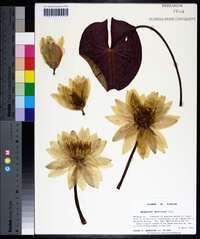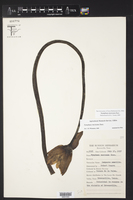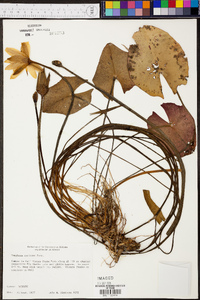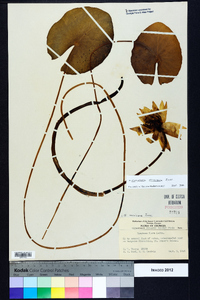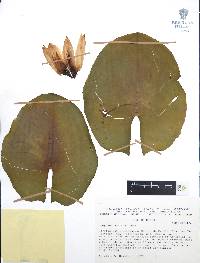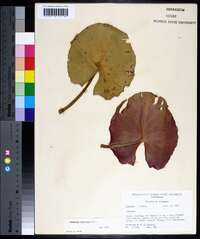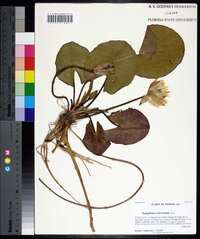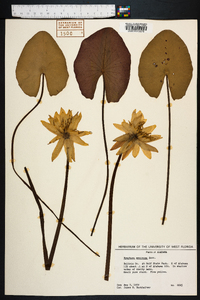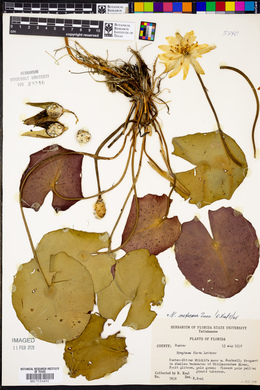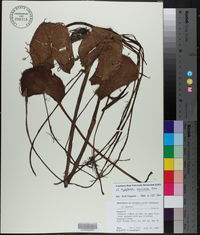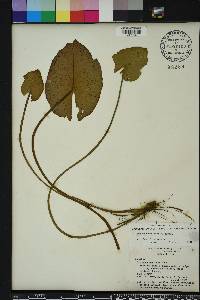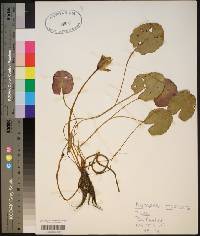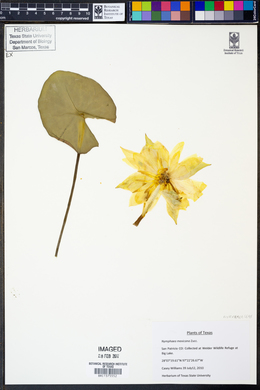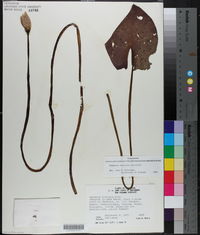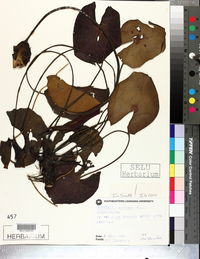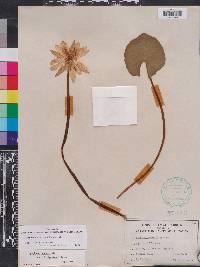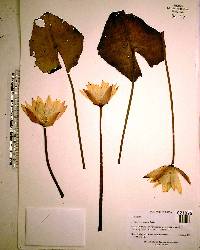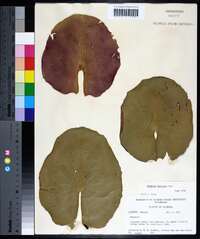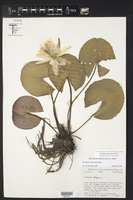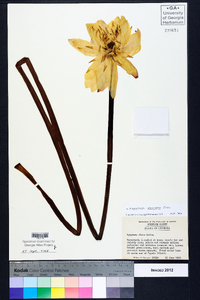
|
|
|
|
Family: Nymphaeaceae
Banana Water-Lily, more...yellow waterlily, banana waterlily
[Castalia flava (Leitner) Greene, moreNymphaea flava] |
Rhizomes unbranched, erect, cylindric; stolons elongate, spongy, developing clusters of curved, fleshy, overwintering roots resembling tiny bananas at terminal nodes. Leaves: petiole glabrous. Leaf blade abaxially purplish with dark flecks, adaxially green, often with brown mottling, ovate to elliptic or nearly orbiculate, 7-18(-27) × 7-14(-18) cm, margins entire or sinuate; venation radiate and impressed centrally, without weblike pattern, principal veins 11-22; surfaces glabrous. Flowers floating or emersed, 6-11 cm diam., opening and closing diurnally, only sepals and outermost petals in distinct whorls of 4; sepals uniformly yellowish green, often red-tinted, evidently veined, lines of insertion on receptacle often slightly prominent; petals 12-30, yellow; stamens ca. 50-60, yellow, connective appendage minute or absent; filaments widest below middle, longer than anthers; pistil 7-10-locular, appendages at margin of stigmatic disk oblong-tapered, to 4.5 mm. Seeds globose, ca. 5 × 5 mm, uniformly covered with hairlike papillae 100-220 µm. 2 n = 56. Flowering spring-fall, mainly summer farther north. Outer coastal plain in alkaline lakes, ponds, warm springs, pools in marshes, sloughs, sluggish streams, ditches, and canals; 0-1100 m; Ala., Ariz., Calif., Fla., Ga., La., Miss., N.C., Okla., S.C., Tex.; ne, c Mexico. Nymphaea mexicana is probably introduced in most inland sites and in California, where it is considered a problematic weed in waterways; it is not common in most states except Florida. The distribution of this species is similar to that of the winter distribution of canvasback ducks, for which the bananalike tubers are an important food (J. E. Cely 1979). This species forms natural hybrids with N . odorata ; the hybrids have been named N . × thiona D. B. Ward (D. B. Ward 1977). Except for stem characteristics, which resemble one or the other parent, and their added vigor, the hybrids are generally intermediate in morphology. They are completely sterile; however, hybrids with the stolon-bearing habit of N . mexicana can form extensive clones and, although somewhat larger in stature than N . mexicana , they closely resemble that less agressive parent and could easily be mistaken for it. Some of the introductions, such as in southeastern Nevada and north-central Kentucky, are clearly this hybrid.
Plant: perennial aquatic herb; fresh-water, usually glabrous, with thick adventitious roots; STEM with erect rhizomes, 1.9-30 cm long, 1.4-6 cm wide, densely covered between the leaf bases with long, light-colored hairs Leaves: 10-20 cm in diameter, glabrous, orbicular to ovate, narrowly peltate, the upper surface of blades bright-green, blotched with brown (at least when young), the lower surface of blades deep purple or purplish green (green in aerial leaves), marked with black dots; margins crenate, wavy at base, nearly entire at apex; sinus slightly open, or the basal lobes overlapping; primary veins on lower surface scarcely visible Flowers: 6-13 cm diameter, faintly scented or odorless; peduncles 3-6 mm diameter, 16-150 cm long; receptacle with four swollen ridges; sepals 4, 3-7 cm long, 0.8-2 cm wide, elliptic, ovate to lanceolate, acute or obtuse, the inner surface yellow; petals 12-23, 2-7 cm long, 1.2-2.2 cm wide, elliptic, the apices rounded, bright-yellow, slightly purplish outside; stamens 50-60, stout, bright golden yellow, the petaloid staminodes mostly 2-2.5 cm long, 1-2.5 mm wide; carpels 7-10; styles short; stigma funnel-shaped, deeply curved Fruit: FRUITS a berry-like capsule, fleshy or spongy, ripening under water, spherical to ovoid, 2-2.5 cm in diameter. SEEDS small, with a floating membranous bell-shaped aril, globose, 2-3 mm long, 4-5 mm wide, very fine dull greenish-black appressed-hairy Misc: Lakes, ponds and slow streams; 1050-1150 m (3500-3700 ft); Apr-Sep (fr. Sep-Oct) Notes: plants reproducing asexually by stolons that in autumn become geotropic and bury their tips 20 cm or more in the mud, forming "brood bodies" (consisting of a row of 3-7 buds on one side, and a cluster of 12 or more fleshy roots 1.3-3.8 cm long on the other) REFERENCES: Ricketson, Jon. 1995. Nymphaeaceae. J. Ariz. - Nev. Acad. Sci. 29(1). 26. FNA 1997, Ricketson 1995, Jepson 2012 Duration: Perennial Nativity: Native Lifeform: Forb/Herb General: Herbaceous, aquatic, fresh water perennials, stems submerged to floating, with erect rhizomes, 1.9-30 cm long and 1.4-6 cm wide, densely covered between the leaf bases with long, light-colored hairs, the rhizomes, unbranched, erect, and cylindric, stolons elongate, spongy, developing clusters of curved, fleshy, overwintering roots resembling tiny bananas at the terminal nodes. Leaves: Blades floating on waters surface, ovate to elliptic or nearly orbiculate, 7-27 mm long and 7-18 cm wide, glabrous, the upper surface of blades bright-green, blotched with brown (at least when young), the lower surface of blades deep purple or purplish green and green in aerial leaves, marked with black dots, primary veins on lower surface scarcely visible, abaxially purplish with dark flecks, margins crenate, wavy at base, nearly entire at apex, sinus slightly open, or the basal lobes overlapping, venation radiate and impressed centrally, without a weblike pattern, principal veins 11-22, blades borne on long, glabrous petioles. Flowers: Yellow, large and showy, 6-11 cm diameter, sepals and outermost petals in distinct whorls of 4, petals elliptic, bright-yellow, slightly purplish outside, 12-23, 2-7 cm long, 12-22 mm wide, with rounded tips, sepals 4, 3-7 cm long, 0.8-2 cm wide, elliptic, ovate to lanceolate, acute or obtuse, the inner surfaces yellow or yellowish green, often red-tinted, evidently veined, lines of insertion on receptacles often slightly prominent, receptacles with four swollen ridges, stamens 50-60, stout, bright golden yellow, connective appendage minute or absent, the petaloid staminodes mostly 2-2.5 cm long, 1-2.5 mm wide, carpels 7-10, styles short, stigmas funnel-shaped, deeply curved, filaments widest below middle, longer than the anthers, pistils 7-10-locular, appendages at margin of stigmatic disk oblong-tapered, to 4.5 mm, flowers submerged, floating, or sometimes scapose-like above the water's surface, opening and closing diurnally, faintly scented or odorless, peduncles 3-6 mm diameter, 16-150 cm long. Fruits: Berry-like capsule, fleshy or spongy, ripening under water, spherical to ovoid, 2-2.5 cm in diameter. Seeds small, globose, with a floating membranous bell-shaped aril, globose, 2-3 mm long, 4-5 mm wide, surfaces appressed-hairy with very fine, dull green Ecology: Found on the outer coastal plain in alkaline lakes, ponds, warm springs, pools in marshes, sloughs, sluggish streams, ditches, and canals, from 3,500-4,000 ft (1067-1219 m); flowering spring-fall. Distribution: Alabama, Arizona, California, Georgia, Florida, Louisiana, Mississippi, New Mexico, North Carolina, Oklahoma, South Carolina, Texas; Mexico. Ethnobotany: Unknown, but other species in the genus have uses; plant used for turtle sickness: trembling, short breath and cough. Etymology: Nymphaea comes from the Greek nymphaia, referring to a water nymph, while mexicana means of or from Mexico. Synonyms: Castalia flava, Nymphaea flava Editor: LCrumbacher2012 |
|
|
|
This project was made possible in part by the Institute of Museum and Library Services [MG-70-19-0057-19].
Powered by Symbiota

